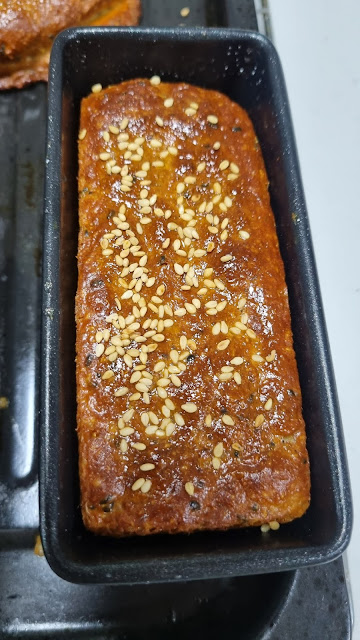In this next tweak of Joe Duff's bread recipe, I switched out the psyllium-husk powder with vital wheat gluten as a way to add structure to the bread. In an attempt to make the bread lighter and more airy (like the Keto King's buns), I changed the rising agent from baking powder to yeast. Behold the results:
A closeup of the burger bun, which rose until the dough ran over the edge of the mini-tin:
A closeup of one of the hot-dog buns:
The underside of the bun:
What the crumb looks like when you break the bun open:
The bread smelled amazing coming out of the oven, thanks to all the herbs and spices. Once again, the hamburger bun is passable; I'll use it with a leftover hamburger tomorrow, and that'll be lunch. (At 650 calories, that's all I can eat: no sides, no salads, nothing—just a simple bacon cheeseburger with sauce and trimmings.) The hot-dog buns have a texture similar to when this was a soda bread, so no real improvement there.
I gave the dough two rises; the first rise was quite impressive, but when I punched down the dough after the rise, it almost seemed to revert to a batter again. The second rise was also impressive (you see how the burger-bun dough ran over the edge of the mini-tin), but when it came time to bake, the dough had almost no oven spring, which is probably why it still ended up being dense. Maybe the dough needs far less water, especially with all the whey protein (which dissolves in liquid). And should I add a little sweetener? I'm thinking that, with more butter in the dough, I could essentially make giant keto croutons. So the recipe's not completely useless; it's just not right for hot-dog buns. The search continues.
Since I already have a good recipe for keto wraps, I might just stick with those for hot dogs, or I could just eat hot dogs with normal buns on my upcoming cheat days.











It's hard to say regarding the water. Usually better hydration will give you a lighter bread. Over the weekend, for example, I made a 100% whole wheat loaf (carbs, but better for you than refined flour) with no added gluten and a fairly high hydration. The dough was so wet and sticky that forming it consisted of me slapping it around until I got a rough boule. I was afraid that it might be too wet to actually rise (I've had very wet doughs just sort of spread out--rising horizontally, shall we say), but I was pleasantly surprised by the result. I ended up with a very light and fluffy loaf with a great oven spring.
ReplyDeleteOf course, that was with wheat flour. I have no idea what the mechanics are for the ingredients you are using. Just a look at the crumb tells me that this is way out of my wheelhouse. With the addition of gluten and the use of yeast instead of soda, I was expecting something quite different, and I was surprised to see that photo of the crumb.
All of this is a very long-winded way of saying: I have no idea what would work for this. I would say keep experimenting and see what happens. Not sure about the sweetener, though. If you are thinking of adding it to provide more food for the yeast, that will not work, as yeast does not eat artificial sweeteners. If you're thinking of adding it just for the flavor, though, that's different.
Yeah, I was thinking about flavor. In my studies, I learned about how yeast doesn't eat artificial sweeteners.
ReplyDeleteC,
ReplyDeleteHere's a link to the modified version of Joe Duff's recipe. The recipe in the right-hand column is the one I just used.
It says I need access, so I requested access.
ReplyDeleteGood that Google is not just showing your stuff to anyone, I guess.
I thought I had set it such that you could just click the link and go, but apparently not. I've now granted you access.
ReplyDeleteYup, got it.
ReplyDeleteMy first thought on seeing the alternative version is that you might not need the xantham gum with all that vital wheat gluten, unless I am mistaking the role of xantham gum.
Also, what kind of yeast are you using? If you are using instant powdered yeast (tiny granules), as opposed to a yeast cake, you do not need to bloom it. In fact, you're probably better off not blooming it, as that will save all the yeast activity for when you actually need it.
As for the rest, 5 grams of yeast would be a lot for that amount of wheat flour, although I suppose it doesn't hurt to add a little extra. And that is quite a low amount of salt--for the same size wheat-flour bread I would add 6 grams, which is about 1.5 tsp (depending on the coarseness of the salt, of course). Unless you are deliberately making this low-sodium (which I suppose is probably not a bad idea), you might try doubling that and seeing what it does to the flavor.